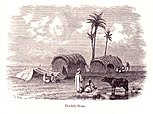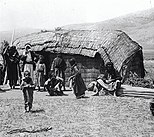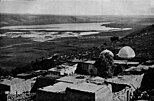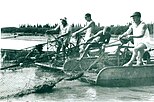Hula Valley
| Hula Valley | |
|---|---|
 | |
| Naming | |
| Native name | עמק החולה (Hebrew) |
| Geography | |
| Location | |
| Coordinates | 33°06′12″N 35°36′33″E / 33.10333°N 35.60917°E |
| Designations | |
|---|---|
| Official name | Hula Nature Reserve |
| Designated | 12 November 1996 |
| Reference no. | 868[1] |
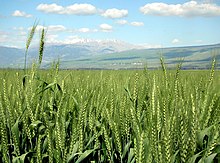
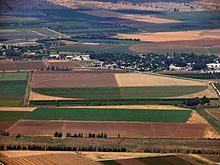
The Hula Valley (Hebrew: עֶמֶק הַחוּלָה, romanized: ʿEmeq haḤūlā; Arabic: وادي الحولة, romanized: wadi al-Ḥūla) is an agricultural region in northern Israel with abundant fresh water that used to be Lake Hula before it was drained. It is a major stopover for birds migrating along the Great Rift Valley between Africa, Europe, and Asia.
Lake Hula and the marshland surrounding it were a breeding ground for mosquitoes carrying malaria and thus were drained in the 1950s.[2] A small section of the valley was later reflooded in an attempt to revive a nearly extinct ecosystem. An estimated 500 million migrating birds now pass through the Hula Valley every year.[3]
Etymology
[edit]Lake Hula was historically referred to by different names. In the 1st century CE, the Jewish-Roman historian Flavius Josephus termed it Semechonitis (Greek: Σημεχωνίτις, romanized: Sēmekhonítis), John Lightfoot writing it as Samochonitis,[4] while in the Talmud it is called the Sea/Lake of Siwkhi ([יַמָּהּ שֶׁל סִיבְכִי] Error: {{Lang}}: invalid parameter: |3= (help)). Both names are identified with the place-name Šamḫuna found in the Amarna letters written in the Akkadian language c. 1360 BCE.[5]
The Waters of Merom has sometimes been used in scientific literature, although that term refers specifically to springs on the western side of the valley.
History
[edit]

Prior to its drainage in the early 1950s, Lake Hula was 5.3 km (3.3 mi) long and 4.4 km (2.7 mi) wide, extending over 12-14 square kilometers. It was about 1.5 m (4 ft 11 in) deep in summer and 3 m (9.8 ft) deep in winter. The marsh-like lake was fed by several perennial springs.[6] The lake attracted human settlement from early prehistoric times. Paleolithic archaeological remains were found near the "Daughters of Jacob Bridge" at the southern end of the valley. The first permanent settlement, Enan (Mallaha), dates from 9,000–10,000 years ago and was discovered in the valley.
The Hula Valley was a main junction on the important trade route connecting the large commercial centre of Damascus with the Eastern Mediterranean coast and Egypt. During the Bronze Age, the cities of Hazor and Laish were built at key locations on this route approximately 4,000 years ago. At some point, the area came under the control of the Israelites, until it was captured by the Neo-Assyrian Empire's armies under Tiglath-Pileser III (reigned 745–727 BC) and its inhabitants were driven away. The Bible records the Waters of Merom, a lake in the valley, as the site of a victory of Joshua over the Canaanites.[7]
Throughout the Hellenistic, Roman, Byzantine and early Arab periods (fourth century BCE to eighth centuries CE) rural settlement in the Hula Valley was uninterrupted. During the Seleucid Empire, the town Seleucia Samulias was founded on the lake shore.
Traditional crops were rice (as early as the Hellenistic period), cotton and sugar cane (brought by the Arabs following their conquest in 636), sorghum and maize (brought after the discovery of the Americas). Water buffalo were introduced in the eighth century supplying milk and serving as beasts of burden.
In the 19th century, the valley, mainly marshy ground and a shallow lake, was inhabited by Ghawaraneh Bedouin[8] who wove matting from the papyrus with which they built their homes. John MacGregor, a Victorian adventurer, was captured with his boat, the "Rob Roy", by dark-skinned Bedouin living in the Hula marshes. He was responsible for the first modern maps of the area.[9] Mortality rates were very high due to the spread of malaria.[citation needed] In 1882, a traveler wrote that the region was "among the finest hunting grounds in Syria," home to "panthers, leopards, bears, wild boars, wolves, foxes, jackals, hyenas, gazelles and otters." During World War II, officers of the British Army wrote about hunting birds there.
In 1908, the Ottoman government granted a concession to drain the marsh to a French firm, which sold it to Lebanese businessmen. In 1933, during the British Mandate, the Zionist Palestine Land Development Company was awarded this concession by the Mandatory government and drew up plans to drain and irrigate the valley which brought scientific expeditions to the area.[9]
A visitor to the area in the 1930s reported that the villages in the area harvested the papyrus for weaving. They used two distinct styles of loom: one for fine mats for interior use, and a second producing longer, coarser mats which were used for constructing huts and shelters.[10]
The first modern Jewish settlement in the Hula Valley, Yesud HaMa'ala on the western shore of the lake, was established in 1883 during the First Aliyah.
In 1948 there were 35 villages in the Hula Valley—12 Jewish and 23 Arab.[11]
Geography
[edit]
The Hula Valley lies within the northern part of the Syrian-African Rift Valley at an elevation of about 70 meters above sea level, and covers an area of 177 square kilometers (25 km by 6–8 km).[dubious – discuss] On both sides of the valley are steep slopes: the Golan Heights to the east and the Upper Galilee's Naftali Mountains to the west rise to 400 to 900 meters above sea level. Basalt hills of about 200 meters above sea level along the southern side of the valley intercept the Jordan River, and are commonly referred to as the basalt "plug", the Korazim block, or Korazim Plateau (actually a temporary geologic base level), as they restrict water drainage downstream into the Sea of Galilee.
Climate
[edit]The Hula Valley has a Mediterranean climate of hot dry summers and cool rainy winters, although its enclosure within two mountain ranges leads to more extreme seasonal and daily temperature fluctuations than in coastal areas. Annual rainfall varies greatly between different parts of the valley and ranges from about 400 millimeters in the south of the valley, to up to 800 millimeters in the north of the valley. More than 1,500 millimeters of precipitation falls on the Anti-Lebanon mountains only a few kilometers north of the valley, mostly in the form of snow, feeding underground springs and the sources of the Jordan River including the Hasbani River, Banias River, Dan River and the el-Malaha Brook, all eventually flowing through the valley, and which, before its drainage, could not easily be distinguished because of the marsh.[12]
Wetland environment
[edit]G. Schumacher, visiting the region in 1883, described the Hula valley in the following terms:
Ard el Huleh. The whole country of the marshes of the Huleh Lake, a swampy territory thickly overgrown with papyrus. It abounds in snipe, wild ducks, francolins and many other kinds of birds, and is consequently much resorted to by the hunter, but as carefully avoided by the inhabitants on account of the noxious fever.[13]
Swamp drainage
[edit]
The draining operations, carried out by the Jewish National Fund (JNF), began in 1951 and were completed by 1958. In 1955 the Israeli government invited John Zuckerman to visit Israel as advisor on a project.[14] It was achieved by two main engineering operations: the deepening and widening of the Jordan River downstream; and two newly-dug peripheral canals diverting the Jordan at the north of the valley. The drying out caused the extinction of the unique endemic fauna of the lake, including the cyprinid fish Mirogrex hulensis or Hula bream,[15] Oxynoemacheilus galilaeus or Galilean Stone Loach, and the cichlid fish Tristramella intermedia or Hulan shortjaw tristramella.[16]
Though perceived at the time as a great national achievement for Israel, with the advent of the modern environmental movement, it became evident that the transformation of the swamp into agricultural land involved significant trade-offs and had effects on the ecosystem that had not been perceived in the first half of the twentieth century, when the major concerns had been the reduction of malaria-bearing mosquitoes and improving economic productivity. In 1963, a small (3.50 km2) area of recreated papyrus swampland in the southwest of the valley was set aside as the country's first nature reserve. Concern over the draining of the Hula was the impetus for the creation of the Society for the Protection of Nature in Israel.[17]
Draining the Hula turned out to be a mixed blessing. Water polluted with chemical fertilizers began flowing into the Sea of Galilee, lowering the quality of its water. The soil, stripped of natural foliage, was blown away by strong winds in the valley, and the peat of the drained swamp ignited spontaneously, causing underground fires that were difficult to extinguish.[3] Eventually part of the valley was transformed back into a wetland habitat.
Hula Nature Reserve
[edit]
The work of a number of scientists and nature lovers made it possible for at least a small part of Hula's wetlands to be preserved. In 1964 the Hula Nature Reserve was officially inaugurated.[18] The Hula Nature Reserve is listed by the Ramsar Convention on Wetlands, as a Wetland of International Importance.[19]
Hula Lake Park
[edit]

Hula Lake Park (אגמון החולה) is located in the southern part of the Hula Valley, north of the nature reserve and distinct from it. It was established as part of a JNF rehabilitation project.[20] In the early 1990s part of the valley was flooded again in the wake of heavy rains. It was decided to develop the surrounding area and leave the flooded area intact. The new site has become the second home for thousands of migrating birds in the autumn and spring.[21] The lake covers an area of one square kilometer, interspersed with islands that serve as protected bird nesting sites. It has become a major stopover for migrating birds flying from Europe to Africa and back, and also a major birdwatching site. In 2011, Israeli ornithologists confirmed that Lake Hula is the stopover point for tens of thousands of cranes migrating from Finland to Ethiopia every winter. In Israel, farmers set out food for them to keep them from damaging crops near the lake.[22][23]
Important Bird Area
[edit]Some 24,000 ha of the northern Hula Valley, including the nature reserve, has been recognised as an Important Bird Area (IBA) by BirdLife International because it supports populations of many species of birds, especially raptors and waterbirds, either as breeding residents, winter visitors or passage migrants. These include marbled teals, pygmy cormorants, sociable lapwings, European honey buzzards, greater and lesser spotted eagles, eastern imperial eagles, Levant sparrowhawks, lesser kestrels and Dead Sea sparrows.[24]
Return of Hula painted frog
[edit]
In November 2011 the Hula painted frog, classified as extinct since 1996 by the IUCN as a result of the marsh drainage, reappeared to park patrollers in HaHula. The reappearance was confirmed by the Israel Nature and Parks Authority. Since the discovery of the first specimen at least ten more have been found, all in the same area. The IUCN has accordingly reclassified the species as critically endangered.[25]
Archaeology
[edit]Archaeological findings in 2009 show that the hominids who inhabited the area exploited Lake Hula fish. Analysis of the fish remains recovered from the archaeological site of Gesher Benot Ya‘aqov (GBY) has shown that they exploited a wide range of fish including catfish, tilapia and carp. Some of the carp were over a meter long.[26] Tools to light fires and crack nuts were also discovered at the site.[27]
Cultural references
[edit]In December 2007 Israel issued a set of three stamps featuring the Hula nature reserve.[28]
Gallery
[edit]-
Buildings c. 1885
-
Hula. Papyrus harvest 1920
-
Hula. Reed house 1920
-
Hula. Reed house 1920
-
Hula. Mat weaving 1925
-
Papyrus raft 1926
-
Hula. Cotton harvest 1930
-
View from Al-Nabi Yusha' 1930s
-
Al-Salihiyya c. 1936. Woman weaving papyrus mat
-
Hula bedouin 1938
-
Malaria clinic, 1938
(Dr. Gideon Mer in the centre with hat) -
Fishermen at Lake Hula
ca. 1943 -
Dederra, 1944 – only Zionist outpost on eastern side of Hula; used by the Palmach for smuggling immigrants
-
Buffalo soaking in a mud hole, 1946
See also
[edit]- Battle of Lake Huleh (1157)
- Battle of Lake Huleh (1771)
- Museum of Prehistory of the Hulah Valley
- Acanthobrama hulensis
- Tristramella intermedia
References
[edit]- ^ "Hula Nature Reserve". Ramsar Sites Information Service. Retrieved 25 April 2018.
- ^ The Drainage of the Hula Swamps, Yehuda Karmon
- ^ a b The Hula Reserve[permanent dead link]
- ^ John Lightfoot, From the Talmud and Hebraica, Vol. 1, p. 139
- ^ Petrie, William Matthew Flinders (1898). Syria and Egypt: From the Tell El Amarna Letters. Methuen & Company. p. 70.
- ^ William McClure Thomson, The land and the Book; or, Biblical illustrations drawn from the manners and customs, scenes and scenery of the Holy Land, Volume 1, New York 1859, p. 320
- ^ Book of Joshua 11:5–7
- ^ Thomson, W.M. (1872) The Land and the Book; or Biblical Illustrations drawn from the manners and customs, the scenes and scenery of The Holy Land. T. Nelson & son. p. 253
- ^ a b History of the Hula Valley Archived 2012-04-25 at the Wayback Machine
- ^ Larsson, Theodore (October 1936). "A Visit to the Mat Makers of Huleh". Palestine Exploration Fund Quarterly Statement. 68 (4): 225–229. doi:10.1179/peq.1936.68.4.225.
- ^ Tucker, Spencer; Roberts, Priscilla Mary (2008). The Encyclopaedia of the Arab-Israeli Conflict: A Political, Social, and Military History. Vol. One, A–H. ABC-CLIO. p. 458. ISBN 978-1-85109-841-5.
- ^ Velde, van de, C.W.M. (1854). Narrative of a journey through Syria and Palestine in 1851 and 1852. Vol. 1. William Blackwood and son. p. 168.
- ^ Schumacher, G. (1888). The Jaulân: surveyed for the German Society for the Exploration of the Holy Land. London: R. Bentley. p. 95.
- ^ "Register of the Zuckerman (John) Huleh Reclamation Papers, 1948-1989". www.oac.cdlib.org. Retrieved 2020-03-04.
- ^ Goren, M. (2014). "Mirogrex hulensis". IUCN Red List of Threatened Species. 2014: e.T73A19848542. doi:10.2305/IUCN.UK.2014-1.RLTS.T73A19848542.en. Retrieved 12 November 2021.
- ^ Goren, M. (2006). "Tristramella intermedia". IUCN Red List of Threatened Species. 2006: e.T60792A12399367. doi:10.2305/IUCN.UK.2006.RLTS.T60792A12399367.en. Retrieved 12 November 2021.
- ^ Tal, Alon (2002). Pollution in a Promised Land: An Environmental History of Israel. Berkeley, CA: University of California Press. p. 115. ISBN 978-0-520-23428-4.
- ^ Official webpage of the Hula Nature Reserve at the Israel National Parks Authority website "Hula Nature Reserve". Archived from the original on 2016-06-17. Retrieved 2016-06-22.
- ^ "The Ramsar Sites | Ramsar". Archived from the original on 2019-11-16. Retrieved 2016-08-11.
- ^ "The Hula Valley- Bird Watching Site". Haaretz. 25 March 2008.
- ^ "The Hula Valley- Bird Watching Site". Haaretz.[dead link]
- ^ "Israeli ornithologists confirm flight path of migrating cranes". Haaretz. 2011-03-04.
- ^ "No-fly Zone: For Birds, Too, the Mideast Poses a Growing Danger". Haaretz. 29 August 2009. Retrieved 29 December 2019.
- ^ "Hula valley". BirdLife Data Zone. BirdLife International. 2021. Retrieved 23 February 2021.
- ^ Yong, Ed (2013-06-04). "'Extinct' frog is last survivor of its lineage". Nature. Nature Publishing Group. Retrieved 2013-06-07.
- ^ Alperson-Afil, Nira; Sharon, Gonen; Kislev, Mordechai; Melamed, Yoel; Zohar, Irit; Ashkenazi, Shosh; Rabinovich, Rivka; Biton, Rebecca; Werker, Ella; Hartman, Gideon; Feibel, Craig; Goren-Inbar, Naama (18 December 2009). "Spatial Organization of Hominin Activities at Gesher Benot Ya'aqov, Israel". Science. 326 (5960): 1677–1680. Bibcode:2009Sci...326.1677A. doi:10.1126/science.1180695. PMID 20019284. S2CID 762576.
- ^ Goren-Inbar, Naama; Alperson, Nira; Kislev, Mordechai E.; Simchoni, Orit; Melamed, Yoel; Ben-Nun, Adi; Werker, Ella (30 April 2004). "Evidence of Hominin Control of Fire at Gesher Benot Ya'aqov, Israel". Science. 304 (5671): 725–727. Bibcode:2004Sci...304..725G. doi:10.1126/science.1095443. PMID 15118160. S2CID 8444444.
- ^ "Hula Reserve series" (in Hebrew). israelphilately.org.il. Archived from the original on 2011-07-23.
External links
[edit]![]() Media related to Hula Valley at Wikimedia Commons
Media related to Hula Valley at Wikimedia Commons
- Hula Valley
- Landforms of Northern District (Israel)
- Lakes of Israel
- Nature reserves in Israel
- Protected areas of Northern District (Israel)
- Ramsar sites in Israel
- Regions of Israel
- Shrunken lakes
- Valleys of Israel
- Tourist attractions in Israel
- Jordan River basin
- World Heritage Tentative List
- Important Bird Areas of Israel


